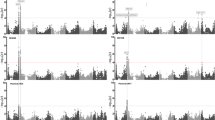Summary
Three methods were evaluated as potential aids in identifying superior crosses early in the breeding program: (1) F1 yield, (2) F2 yield, and (3) midparental yield. Two sets of spring wheat (Triticum aestivum L. em. Thell.) crosses and parents were evaluated in replicated single row plots in F1 and in replicated multi-row plots in F2 over a period of five years. On the basis of F1 yields, two of the highest yielding and two of the lowest yielding crosses in each set were chosen for a more detailed selection study in subsequent generations.
In Set 1, random F2 head selections for each of the selected four crosses were evaluated in 3-row yield plots in F4. In Set 2, F2 plant selections were made on the basis of head weight and the highest yielding 10% evaluated for yield in F4.
Lines of crosses identified as high yielding in F1 had significantly greater mean yields in F4 than those of crosses that were low yielding in F1. The high yielding crosses had three to four times as many lines yielding in the top 10% in F4 than did the low yielding crosses.
Correlations for yield were obtained between F1 and F2 in different years, F2 and midparents in the same year, lower or no correlations between F1 and midparents in the same year, and no correlations between F1 and midparent and F2 and midparent in different years. It is suggested that larger plot sizes rather than single rows be used to evaluate parents.
Midparental yield, F1 yield and F2 yield tests are recommended as a progressive set of screening tests for a given set of crosses to effectively maintain the superior crosses in the breeding program.
Similar content being viewed by others
References
Bhatt, G. M., 1973. Comparison of various methods of selecting parents for hybridization in common bread wheat (Triticum aestivum L.). Aust. J. Agric. Res. 24: 457–464.
Briggle, L. W., E. L., Cox & R. M., Hayes, 1967. Performance of a spring wheat hybrid, F2, F3 and parent varieties at five population levels. Crop Sci. 7: 465–470.
Carver, M. F. F., 1977. The influence of seed size on the performance of cereals in variety trials. J. Agric. Sci. 89: 247–249.
Fowler, W. L. & E. G., Heyne, 1955. Evaluation of bulk hybrid tests for predicting performance of pure line selections in hard red winter wheat. Agron. J. 47: 430–434.
Harrington, J. B., 1940. Yielding capacity of wheat crosses as indicated by bulk hybrid tests. Can. J. Res., Sec. C. 18: 578–584.
Keydel, F, 1973. Investigations on the yielding properties of F1 hybrids of winter wheat. Z. Pflanzenzüchtg. 69: 239–255.
Knott, D. R., 1965. Heterosis in seven wheat hybrids. Can. J. PLant Sci. 45: 499–501.
Jordaan, J. P. & F. X. Laubscher, 1968. The repeatability of breeding values for eleven wheat varieties estimated over generations. 3rd Int. Wheat Genetics Symposium, Canberra, Australia. Aug. 5–9, p. 416–420.
Lupton, F. G. H., 1965. Studies in the breeding of self-pollinating cereals. 5. Use of incomplete diallel in wheat breeding. Euphytica 13: 331–352.
Sampson, D. R., 1972. Evaluation of nine oat varieties as parents in breeding for short stout straw with high grain yield using F1, F2, and F3 bulked progenies. Can. J. Plant Sci. 52: 21–28.
Stoskopf, N. C. & D. T. Fairy, 1975. Breeding schemes and procedures to obtain yield in cereals. Proc. of the Eastern Wheat Workers' Conference, Wooster, Ohio, April 8–10.
Whitehouse, R. N. H., J. B., Thompson & M. A. M., Do, Valle Ribeiro, 1958. Studies on the breeding of self-pollinating cereals. 2. The use of a diallel cross analysis in yield production. Euphytica 7: 147–169.
Author information
Authors and Affiliations
Rights and permissions
About this article
Cite this article
Nass, H.G. Selecting superior spring wheat crosses in early generations. Euphytica 28, 161–167 (1979). https://doi.org/10.1007/BF00029186
Received:
Issue Date:
DOI: https://doi.org/10.1007/BF00029186




